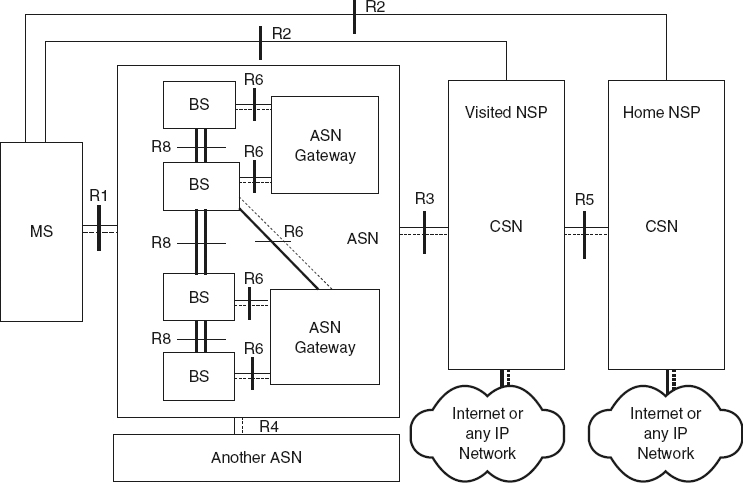Comparing Network Architectures
Conceptually, LTE and WiMAX have similar network architectures. Both have an all-IP flat architecture. Their network architectures can be divided into three logical parts: Mobile Station (MS)/User Equipment (UE), Access Service Network (ASN)/Core Network (CN) and Connectivity Service Network (CSN)/Protocol Data Network (PDN). Figure 15.4 and Figure 15.5 show the architectures of WiMAX and LTE respectively. The two networks differ in the functionalities performed by the first part, but not its architectural aspect. Hence, in the sequel, we shall highlight the differences between the two technologies in the last two parts.
ASN/AN (E-UTRAN) and the MME and the S-GW
The ASN in WiMAX consists of an ASN Gateway (ASN-GW) and a BS. The AN (EUTRAN) consists of a network of eNBs connected to each other. The BS is functionally similar to an eNB. The main task of the two is handling traffic to and from the MS. This involves packet transmission, HARQ, link adaptation, and QoS enforcement at the user plane. At the control plane, it involves radio resource management, connection management, handover triggering and DHCP proxy at the control plane.
Figure 15.4 WiMAX Network Architecture.

Figure 15.5 LTE Network Architecture.
The gateway function played by the ASN-GW in the WiMAX is provided by two entities in LTE which are part of the EPC, namely the MME and the S-GW. These two are functionally similar to the SGSN in UMTS or the PDSN in EVDO.
The ASN-GW in WiMAX as well as the MME and the S-GW in LTE provide the air-interface to the core network and are considered the aggregation point of the users' traffic. Among the tasks of these entities are the AAA client procedures, mobility management by establishing, maintaining and terminating mobility tunnels with the eNB/BS.
Irrespective of the similarities in functionality between WiMAX and LTE, significant differences exist. For example LTE separates the traffic control plane handling from the traffic user plane handling. MME is defined to handle the control plane traffic while the S-GW is defined to handle the user plane traffic. WiMAX does not separate the two planes at least in definition, where the control and the user planes' traffic are handled by the ASN-GW. In addition, LTE defined entities (part of MME and S-GW) to provide interface between LTE and legacy 3G networks such as WCDMA and EVDO. However, WiMAX is still working on this unfinished functionality.
CSN/PDN-GW
CSN provides connectivity to other networks such as Internet and the PSTN (Public Switched Telephone Network). The main task of CSN is to provide core IP functionality and an anchor for mobility (Mobile IP Home Agent MIP-HA) from WiMAX to/from other network technologies. The PDN-GW provides similar mobility functionality to the HA of the CSN. Concerning mobility functionality, LTE provides proxy MIPv6 while IEEE-IEEE 802.16-2009 left this functionality as an option.
Both IEEE 802.16m BS and LTE-Advanced eNB are standardized to support interoperability with IEEE 802.16-e and IEEE 802.16-2009 and LTE respectively. Additionally, LTE-Advanced eNB and IEEE 802.16m BS will be capable to serve legacy UE and MS.

